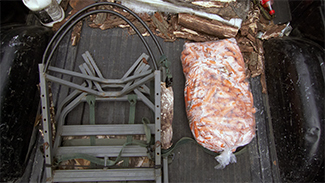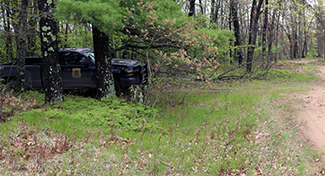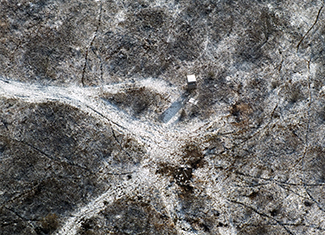Conservation officers helping curb the risk of wildlife disease
By KATIE GERVASI
Michigan Department of Natural Resources

People might not think immediately of Michigan’s conservation officers as being on the front lines in the fight against wildlife diseases.
However, the roughly 200 men and women sworn to protect the state’s natural resources are vitally important in helping to control disease threats, including bovine tuberculosis and chronic wasting disease.
This disease, always fatal to those white-tailed deer contracting it, has been detected in several Michigan counties, prompting the Michigan Natural Resources Commission and Department of Natural Resources to implement deer baiting and feeding bans in effect for this fall’s hunting seasons.
“These bans are in place to try to help minimize the amount of contact between deer congregated where baiting and feeding occur,” said John Pepin, Michigan DNR deputy public information officer. “Chronic wasting disease can be transmitted through direct deer-to-deer contact, or by contact with saliva, feces, urine, blood and contaminated feed, water, plants, soil or carcass parts.”
In the Lower Peninsula, a ban went into effect Jan. 31 for all 68 counties south of the Mackinac Bridge. Regulations also restrict carcass movement in the Lower Peninsula and prohibit importation of certain carcass parts statewide.
In the Upper Peninsula, baiting and feeding deer is banned in a core CWD surveillance area situated in portions of Dickinson, Menominee and Delta counties. Throughout the rest of the U.P., baiting and feeding is allowed, but must be done in line with state regulations.
Tomorrow is Michigan’s opening day of firearm deer hunting season. For those who have been getting ready by baiting deer in violation of the law, odds are good conservation officers are aware.
Whether in the air or on the ground, patrols have been ongoing for weeks and are conducted by a range of means.
|

Conservation officers are responsible for locating illegal bait, educating hunters and enforcing current regulations to help reduce the risk of CWD. Officers manage deer and elk carcass movement by conducting increased patrols, enforcement and surveillance at primary access points between counties and states.
Illegal baiting can result in court costs and fines, a revoked hunting license, confiscated game and jail time.
“We’re watching the borders,” said Sgt. Jeff Rabbers, who supervises conservation officers in west Michigan. “We sit along major highways looking for deer being transported. We may rely on motor vehicle code violations to initiate a vehicle stop to address potential game violations.”
Because CWD can remain in the soil, it’s important not to transport deer out of the CWD management zone or core area in the Lower Peninsula, to properly dispose of carcass remains and abide by the no baiting regulations.
“Our goal is to reduce the rate of spread, to keep it centralized and not allow it to move out of those spots,” Rabbers said.
Prior to their taking effect, conservation officers spent 2018 educating the public about the major baiting and feeding rule changes.
“We get a lot of questions about the baiting,” said Conservation Officer Carter Woodwyk, who patrols Allegan County. “It seems like people are trying to do their best and follow the rules.
“I prepare for deer season by educating people before the time comes. Obviously, nobody wants to get in trouble. CWD is such a big thing right now, everyone wants to help out as much as they can, nobody wants to see a deer herd get taken over by CWD.”
Infected deer herds threaten the long-term viability of those deer populations, as well as pose negative impacts to future deer hunting opportunities.
In 2018, conservation officers made over 2,000 arrests related to wildlife violations, including 44 arrests related to CWD baiting and feeding violations within the CWD core management zone in Lower Michigan.
A formidable foe
DNR wildlife staffers know CWD is a contagious, fatal disease among the deer, elk and moose (cervid species). The affliction is caused by a normal protein, called a “prion,” that folds incorrectly. Misfolded prions cause a degeneration of the brain, resulting in emaciated deer, abnormal behavior, loss of bodily functions and death.
|

There is no cure for this animal disease.
While there is no evidence of humans contracting CWD, the World Health Organization and the U.S. Centers for Disease Control and Prevention advise against eating meat from infected animals.
The disease may be present in an animal for years before symptoms are displayed in its late stages. Putting bait on the landscape alters deer movement and behavior and increases deer interactions between different social groups.
This increased interaction presents a risk of transmitting disease if it is present within the deer herd. Though deer are social animals, interacting every day, baiting increases this activity and elevates the potential for spreading disease by drawing deer to locations where bait is replenished by hunters over time.
“Once the disease gets into the soil, it’s there forever,” Rabbers said.
It's important to manage the spread of wildlife disease to prevent a decline in healthy wildlife.
“We’re trying to be proactive and stop some of the activity,” Rabbers said. “There’s potential for increased spread of this disease. It will impact the population size. It’s going to affect the future of whitetail deer in Michigan. Regulations are asset protection. Everyone is impacted by Michigan’s natural resource industry – local businesses, restaurants – everything.”
Boots on the ground
In contrast to last year’s largely educational efforts, conservation officers will be taking a more aggressive approach to CWD regulations enforcement this year. The baiting and feeding restrictions are defined by distinct boundaries in both Michigan peninsulas.
“The new regulations have been in place since the beginning of 2019,” said Gary Hagler, chief of the DNR’s Law Enforcement Division. “There is no exception for baiting in the Lower Peninsula during the firearm deer-hunting season. It’s as clear as that – it’s not allowed, and it will be enforced as a zero-tolerance policy.
“While there are limited portions in the U.P. where baiting is restricted, the concept was introduced to the area last year and has been heavily communicated.”
Conservation officers, who are strategically placed statewide, live in the communities they patrol and have established relationships and an enhanced awareness of the places where they work.
They may learn about illegal bait from a confidant, an anonymous tip to the DNR’s Report All Poaching hotline (1-800-292-7800) or while out on routine patrol.
|

For hunters, being successful with bait takes patience. It’s unlikely to find a trophy buck grazing over recently placed bait. Therefore, bait is commonly placed by hunters ahead of the hunting season.
Conservation officers patrol for deer baiting ban violators well before opening day.
Eyes in the sky
Throughout the state, conservation officers have already conducted “bait flights” and patrols to identify suspicious baiting activity.
The officers determine where to conduct bait flights based on historical problem areas, complaints and suspicious activity they’ve witnessed while patrolling.
“Once the plane leaves the airport, the officers disperse into the identified areas,” Rabbers said. “The officers on the ground are listening to the officer in the plane, who is constantly talking to the pilot, indicating what they see. The officers on the ground are tracking the conversation to determine where they need to drive.”
Pilots are vital assistants to conservation officers.
The officer and the pilot are both looking out the window with binoculars. The pilot is spinning and dropping the plane so the officer can get a closer look, along with plotting coordinates and taking photos as evidence. The pilot indicates the photograph number and a description of the photo for the officer’s documentation.
If officers identify baiting activity from the air, they likely will continue to investigate on the ground.
“When we conduct bait flights, it’s not as critical to get an officer there right away,” said Woodwyk. “The bait’s not going to go away. If we catch them with bait now, they’re probably going to have bait out there on opening day. They want their chance to shoot a deer.”
Sometimes, conservation officers in the plane may communicate what they see to officers on the ground, so they can immediately address violations.
“When you’re in the air, you can tell you’re on a property managed by an individual or the same group of people because you’ll see multiple hunting sites that are all set up the same way,” Woodwyk said.
Conservation officers aren’t just looking for bait, they’re also looking for animal movement.
|

“If you see a beat-down deer trail, you might find bait or a spin-cast feeder at the end of the trail,” said Woodwyk. “It’s amazing what you see from the air: you see the layout of everything that you wouldn’t be able to see on the ground. If you see a blind, it’s easy to see if there’s bait nearby.”
Conservation officers suggest baiting really isn’t worth the risk.
“Flights are a simple procedure that can be effective,” Rabbers said. “Our stance for the first couple years has been education, turned into strict enforcement. As a result, we’re seeing more compliance and less violations.”
Preventing the spread of animal disease is important to sustaining Michigan’s valuable natural resources, including white-tailed deer herds.
Conservation officers are frontline defenders tasked with informing the hunting public and enforcing baiting regulations to help prevent the spread of CWD and other wildlife diseases.
Their important efforts are helping sustain Michigan’s longstanding deer hunting heritage for the hunters of today and tomorrow.
Current deer hunting regulations are available online and can be downloaded to your mobile device at Michigan.gov/DNRDigests.
Interested in becoming a conservation officer? The next recruit school begins in July! Learn more at Michigan.gov/ConservationOfficers.
|
Check out previous Showcasing the DNR stories in our archive at Michigan.gov/DNRStories. To subscribe to upcoming Showcasing articles, sign up for free email delivery at Michigan.gov/DNR.
/Note to editors: Contact: John Pepin, Showcasing the DNR series editor, 906-226-1352. Accompanying photos and a text-only version of this story are available below for download. Caption information follows. Credit Michigan Department of Natural Resources, unless otherwise noted.
Text-only version of this story.
Bait: A conservation officer locates bait that was going to be used illegally in the back of a pickup truck.
Camp: Conservation Officer Jeff Rabbers contacts a deer camp owner.
Feeder: From the airplane, a conservation officer identifies deer eating bait that was dispensed by a spin-cast feeder, near a hunting blind.
Hunters: Conservation Officer Jeff Rabbers talks with two deer hunters.
Panel: The instrument panel inside a “bait flight” plane is shown.
Plane: Conservation Officer Justin Ulberg stands next to a plane used for “bait patrols.”
Pumpkins: During a bait flight, a conservation officer locates pumpkins spread in a field as bait for deer, located near a hunting blind.
Truck: Conservation officers patrol main access points between counties and states to manage transportation of deer and elk (cervids)./
|